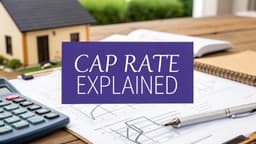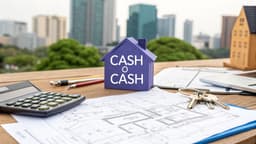So, you're wondering how much you can really make on Airbnb. Let's get straight to the point.
While you'll often see an average Airbnb income figure floating around $1,150 per month, that number is just the tip of the iceberg. Think of it as a starting point. Your actual earnings can swing wildly—from a few hundred dollars to well over $5,000—all depending on a handful of key factors we’ll break down.
Unpacking the Average Airbnb Income
Before you start forecasting your profits, it's crucial to get a handle on the baseline. The "average Airbnb income" isn't a guarantee; it's a national benchmark. It’s a single data point in a massive, diverse market that gives you a general idea, but the real story is always in the details.
Globally, the typical host recently pulled in around $13,800 in annual income. That's a massive 43.8% jump compared to previous years, which tells us the short-term rental market is not just strong—it's booming.
But that global average lumps everyone together, from the host renting a spare room on weekends to the investor managing a luxury beach house. To learn more about what's driving these numbers, check out the latest global hosting trends and statistics on Helplama.com.
To give you a quick snapshot, here are the key benchmark figures all in one place.
Average Airbnb Host Income at a Glance
This table summarizes the core earnings data to give you a quick reference point for what's possible.
| Metric | Average Figure | Context |
|---|---|---|
| Monthly Income | ~$1,150 | A common U.S. benchmark, but highly variable. |
| Annual Income | ~$13,800 | A global average reflecting a wide range of host types. |
| Annual Growth | +43.8% | Shows significant recent growth in host earnings worldwide. |
| Earnings Range | $200 – $5,000+ /mo | Illustrates the vast difference based on property, location, and strategy. |
As you can see, the potential is there, but the real question is: where will your property land on that spectrum?
What Does "Average" Really Mean?
Let’s be honest, the word "average" can be pretty misleading. It mashes together countless different scenarios, creating a number that probably doesn't reflect your specific situation at all.
To get a clearer picture, you have to break it down.
- Property Type: A four-bedroom house in a vacation spot simply won't earn the same as a studio apartment in the suburbs.
- Location: An urban condo near major attractions has a totally different income potential than a quiet cabin in the woods.
- Availability: A property rented out 300 days a year is going to crush the revenue of one that's only available on holidays.
This is where the numbers start to make sense. You're not just a statistic; you're a unique combination of these factors.
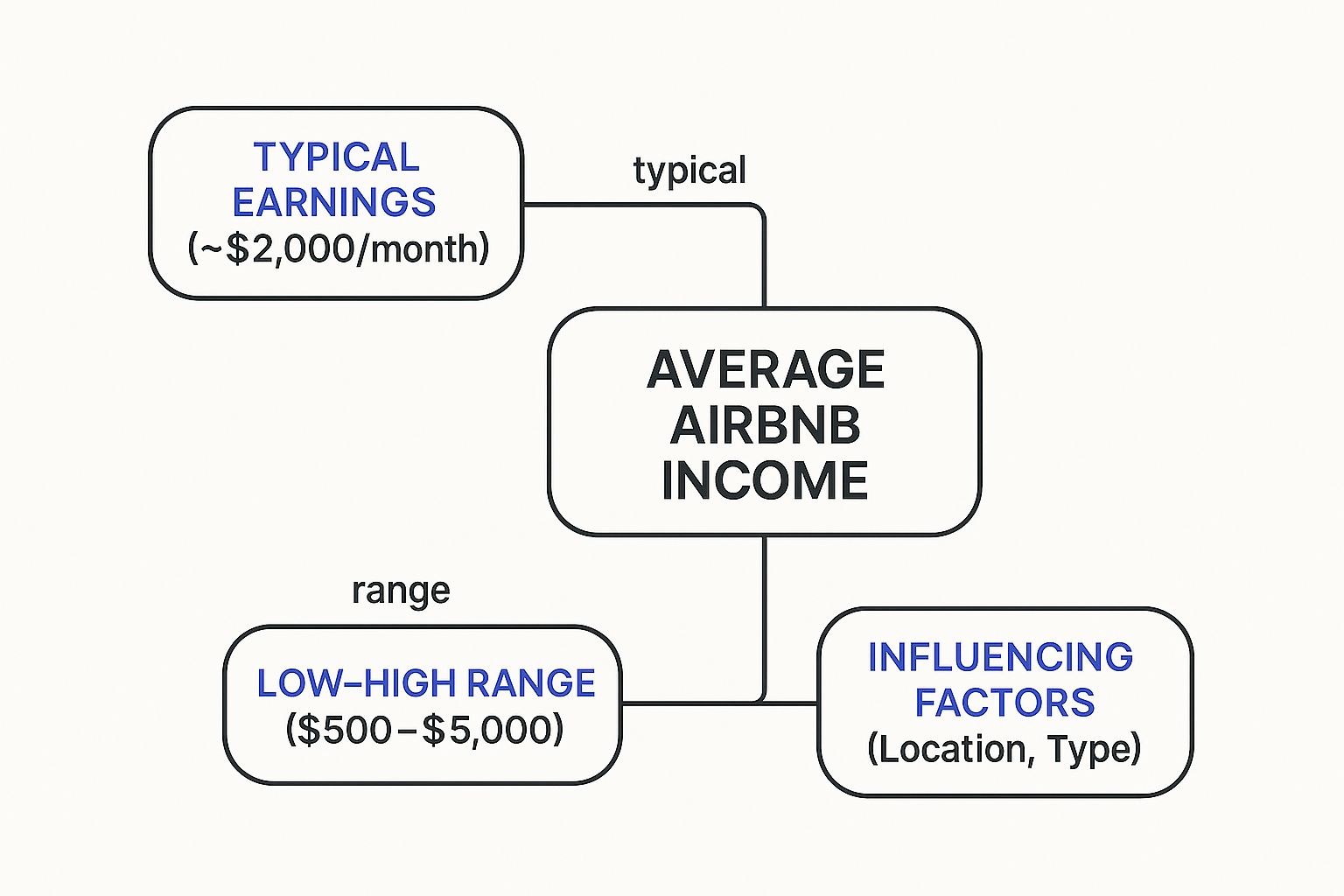
As the infographic shows, that final "average" income is really just the outcome of a wide earnings range. The real drivers are powerful variables like your property's location and type.
From Averages to Actionable Insights
So, what should you do with all this? Use the average income figure as a reference point, not a rulebook. It confirms that hosting can be a profitable gig, but it also screams the need for a personalized strategy.
Your goal isn't to hit some generic average. It’s to understand your own market and your own property so you can blow past it.
The most successful hosts don't chase a generic average. Instead, they focus on mastering the variables within their control—like pricing, guest experience, and listing quality—to maximize their unique property's potential.
Throughout this guide, we're going to move way beyond these initial benchmarks. We’ll dissect the specific factors that truly drive revenue, from location and seasonality to amenities and reviews. This will give you the tools to build a realistic forecast for your own potential income and create a solid strategy to get there.
The 5 Key Factors That Drive Your Airbnb Earnings
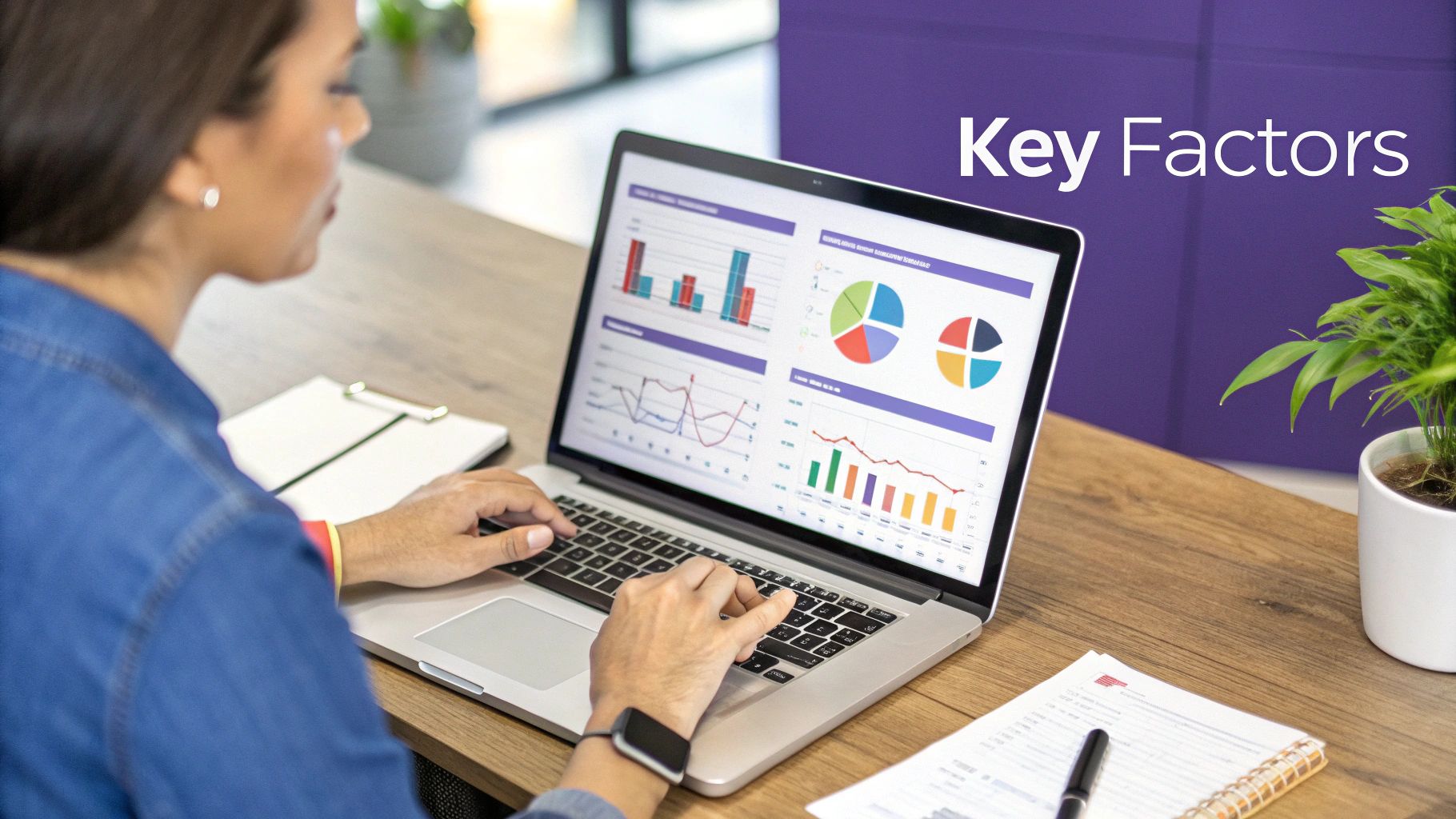
Knowing the "average Airbnb income" is a good starting point, but it won't tell you what your property can pull in. To really get a handle on your potential, you have to think less like a host and more like a strategist. Your earnings aren't a lottery—they're the direct result of five key factors working in concert.
Think of it like a recipe. You can have the best ingredients, but if you miss one, the whole dish can fall flat. Nailing these five elements is how you stop hoping for bookings and start building a predictable, profitable business. Let's break them down.
Location and Market Demand
Location is, without a doubt, the most powerful driver of your earning potential. It’s the foundation for everything else. An amazing property in a market with zero demand will always lose to an average one in a travel hotspot.
Your property's location is its storefront. A shop on a busy main street gets way more foot traffic than one tucked away on a side alley. For Airbnb, that "foot traffic" is the search volume from travelers looking to book in your area.
For example, a condo in downtown Nashville will pull in guests all year round—tourists, business travelers, you name it. A cabin in the Smoky Mountains, on the other hand, will likely have huge peaks in summer and fall but get quiet in the winter. Both can be incredibly profitable, but their income patterns are completely different.
Property Type and Size
Once you've got a handle on your market's demand, your property's type and size enter the picture. A bigger house with more bedrooms doesn't automatically mean more money. The real key is matching your property to the type of travelers who visit your area.
A massive five-bedroom home is perfect for a family destination like Orlando. But in a business-focused city where most travelers are solo or couples, that same house might sit empty. A stylish one-bedroom apartment with a dedicated workspace would likely do much better there.
Think about who you're serving:
- Studio Apartment: Perfect for solo travelers or couples in dense urban cores.
- Two-Bedroom Condo: Hits the sweet spot for small families or friends in tourist-heavy cities.
- Large Single-Family Home: A go-to for big family trips in classic vacation spots.
- Unique Stay (Yurt, Airstream): Caters to travelers seeking an experience in scenic or quirky locations.
Your property type defines your ideal guest, which then shapes your pricing, your marketing, and how often you can expect to be booked.
Seasonality and Pricing Strategy
Let's be real: no market has perfectly steady demand 365 days a year. Seasonality creates an ebb and flow, and if you don't adapt, you're leaving money on the table. A "set it and forget it" price is one of the biggest mistakes a new host can make.
Think like an airline. The price of a flight changes based on the season, the day of the week, and how close you are to the travel date. Your Airbnb should work the same way. A dynamic pricing strategy means you raise your rates to capture peak demand during holidays and local events, then lower them just enough to stay booked during the slow season.
In the United States, detailed industry analysis reveals that the typical Airbnb host earned about $14,000 in supplemental annual income, with average monthly revenues reaching $4,300 in recent periods. These figures reflect the combined impact of smart pricing and high-demand seasons.
Occupancy Rate
Your occupancy rate is simply the percentage of available nights your property gets booked. It's a simple number with a huge impact on your bank account. A high nightly rate means nothing if your calendar is empty half the month.
A few things directly impact your occupancy:
- Competitive Pricing: If you're priced way above your neighbors, guests will just book with them instead.
- Minimum Stay Requirements: A strict seven-night minimum might be great in peak season, but it will kill your bookings in the off-season when people are looking for quick weekend getaways.
- Listing Quality: Professional photos, a killer description, and a full list of amenities make people want to click "Book Now."
The goal is to find that perfect balance between your nightly rate and your occupancy. A slightly lower price that keeps you booked 85% of the time will almost always beat a high price that only gets you 50% occupancy.
Guest Reviews and Property Presentation
Finally, we have guest reviews—your online reputation. In this business, social proof is everything. A long history of glowing, five-star reviews builds trust, pushes your listing up in the search results, and lets you charge a premium.
On the flip side, a few bad reviews can sink you. Cleanliness, good communication, and an accurate listing are non-negotiable. A spotless, well-maintained property is the bare minimum. Using an ultimate short-term rental cleaning checklist can help you build a system to nail guest expectations every single time.
These five factors are all connected. A great location (Factor 1) with the right property (Factor 2) needs a smart pricing strategy (Factor 3) to get a high occupancy rate (Factor 4), which only happens if you deliver an experience that earns stellar reviews (Factor 5). Mastering this cycle is how you crush the average Airbnb income.
How Location and Property Type Shape Your Bottom Line
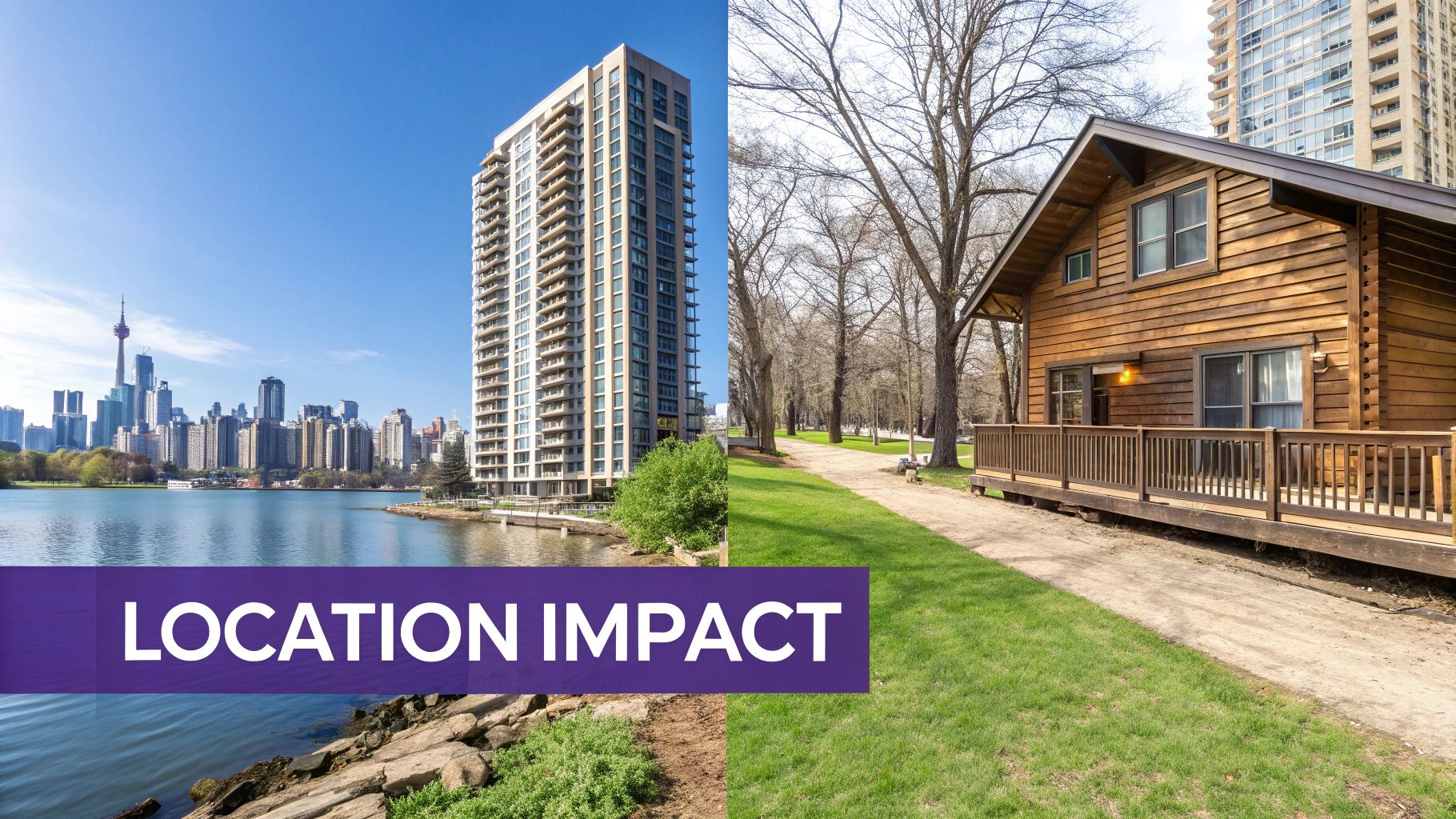
If your average Airbnb income is a house, its foundation is built from two things: location and property type. More than almost any other factor, these two variables set your earning ceiling. It's a classic mistake to think bigger always means more money, but the reality is way more interesting than that.
A tiny studio in a buzzing downtown district can easily pull in more cash than a sprawling four-bedroom house out in the middle of nowhere. Why? Because your income isn't just about the space you offer—it's about the demand for that space.
Think of it this way: your property is the product, and its location is the storefront. You could have the most amazing product in the world, but if you set up shop on a street nobody walks down, you’re not going to make any sales. This is the fundamental dynamic you have to grasp to understand your Airbnb potential.
The Power of Place and Market Demand
Location is everything. It drives how many guests are searching in your area, what they’re willing to pay, and the time of year they’ll be booking. Every market has its own personality and income profile.
- Major Urban Hubs: Think New York, Miami, or Los Angeles. These cities have a built-in, year-round flow of travelers for business, tourism, and events. Competition is fierce, but the constant stream of people means higher occupancy rates and a more stable average Airbnb income.
- Seasonal Vacation Spots: A ski chalet in Aspen or a beach house on the coast are perfect examples. These spots can make a huge chunk of their yearly revenue in just a few peak months. The real challenge is mastering that seasonality—you have to price aggressively in the high season to coast through the quiet months.
- Niche and Rural Destinations: Not every goldmine is a major tourist destination. Properties near national parks, unique wedding venues, or universities have their own powerful micro-economies. Digging into niche markets, like the growing interest in farm stays reflected in reports on the US agro-rural tourism market, can uncover some seriously profitable opportunities off the beaten path.
A property's location sets the fundamental demand curve. Your job as a host isn't just to list a space, but to understand why travelers come to your specific area and align your offering with their needs.
How Property Type Fits the Puzzle
Once you get a feel for your market's demand, your property type helps you zero in on who you're going to attract. It’s all about matching the right kind of space to the right kind of traveler.
A full home in the suburbs is a magnet for families, while a private room in a downtown condo is perfect for a solo business traveler. You're not just renting a bed; you're solving a specific travel problem.
Here’s a quick breakdown of how different property types perform:
- Entire Home/Apartment: This is the bread and butter of Airbnb. Guests love the privacy and space, making it the most sought-after category. It appeals to almost everyone, from families on vacation to couples looking for a weekend escape, and consistently commands the highest nightly rates.
- Private Room: This is a fantastic, budget-friendly option for solo travelers, students, or anyone on a quick trip. The nightly rate is lower, sure, but it’s an incredible way to monetize an extra bedroom with very little upfront cost.
- Unique Stays: Yurts, tiny homes, Airstreams, houseboats—this is where things get fun. These listings aren't just a place to sleep; they are the experience. Because they cater to travelers actively searching for something memorable, they can often charge surprisingly high rates.
The magic happens when you combine location and property type. The table below gives you a hypothetical snapshot of how these two forces work together to create wildly different income potentials.
Hypothetical Annual Income by Property and Location
This table illustrates how potential Airbnb income can vary dramatically based on the combination of property type and market demand.
| Property Type | Urban Center (High Demand) | Vacation Town (Seasonal Demand) | Rural Area (Low Demand) |
|---|---|---|---|
| Studio Apartment | $35,000 | $22,000 | $12,000 |
| 2-Bedroom Condo | $55,000 | $48,000 | $18,000 |
| 4-Bedroom House | $70,000 | $90,000 | $25,000 |
| Unique Stay (e.g., Yurt) | $28,000 | $40,000 | $20,000 |
Note: These figures are illustrative examples to show potential variance.
As you can see, the four-bedroom house is the top earner—but only in the right market. In a rural area, its earning potential drops off a cliff. Meanwhile, a cool yurt in a vacation town can easily outperform a standard apartment, proving that being different can be very, very profitable.
Alright, let's move past the averages and hypotheticals. It's time to roll up our sleeves and figure out what your specific property could actually earn on Airbnb.
Think of this as building a realistic income forecast, not just pulling a number out of thin air. Instead of guessing, we’ll use a simple, data-driven framework to estimate your potential average Airbnb income. It involves a little detective work and some basic math, but it's the single most important step you can take.
You wouldn't open a coffee shop without checking what other local cafés charge, right? Same logic applies here. Let's get to it.
Step 1: Find Your Local Comps
First things first, you need to identify your "comps," which is just industry-speak for comparable listings. These are the active Airbnbs in your immediate area that are most similar to your own property. They're your direct competition and the best source of real-world data you can get.
Finding them is pretty straightforward:
- Open Airbnb in an incognito or private browser window. This is a crucial first step—it ensures your past searches don’t skew the results.
- Search your neighborhood like a guest would. Filter the results to match your property's bedroom count, bathrooms, and key amenities (like a pool or hot tub).
- Zero in on the successful listings. Look for properties with a high number of reviews and a calendar that’s mostly booked up. These are the top performers you want to model your estimates after.
Go ahead and pick three to five of the strongest comps you can find. These properties will be your benchmarks for everything that follows.
Step 2: Calculate the Average Daily Rate
With your comps selected, the next step is to figure out their Average Daily Rate (ADR). The ADR is simply the average price a property gets booked for over a certain period, and it's the cornerstone of your revenue calculation.
To find it, you'll need to dig into the calendars of your chosen comps. Look at their pricing for weekdays, weekends, and any upcoming holidays over the next three months. Don't just glance at tonight's price; you need to see how rates fluctuate with demand.
A good way to get a rough monthly ADR is to add up the nightly rates for about 30 days and divide by 30. For instance, if a comp charges $150 on weekdays and $250 on weekends, its true ADR will land somewhere in the middle. Do this for each of your comps, then average their ADRs together to get a reliable baseline for your market.
Step 3: Estimate Your Occupancy Rate
A sky-high ADR doesn't mean much if your property is sitting empty half the time. Your occupancy rate—the percentage of available nights your property is actually booked—is the other half of the revenue equation. For a new host, aiming for 100% occupancy is both unrealistic and often unprofitable.
Take another look at your comps' calendars. How many nights are booked for next month? A healthy, established listing in a decent market will often hit an occupancy rate between 70% and 85%. But as a new host with zero reviews, you need to be more conservative with your initial projections.
For your first six months, it's much safer to project a cautious occupancy rate of 50-60%. This gives you a realistic buffer while you gather reviews and start climbing the search rankings.
Once you have your numbers, you can multiply your estimated ADR by your projected occupancy rate and the number of days in the month. This gives you a solid gross monthly revenue forecast.
Let's Run the Numbers:
- Estimated ADR: $200
- Projected Occupancy Rate: 60% (or 0.60)
- Days in Month: 30
Calculation: $200 (ADR) x (30 days x 0.60) = $3,600 (Gross Monthly Revenue)
This simple formula turns abstract market data into a tangible income estimate. While powerful tools like AirDNA can provide more granular analytics, doing this manually gives you an invaluable, on-the-ground feel for your market's dynamics and what really drives the average Airbnb income in your specific neighborhood.
Looking Beyond Revenue to Understand True Profit
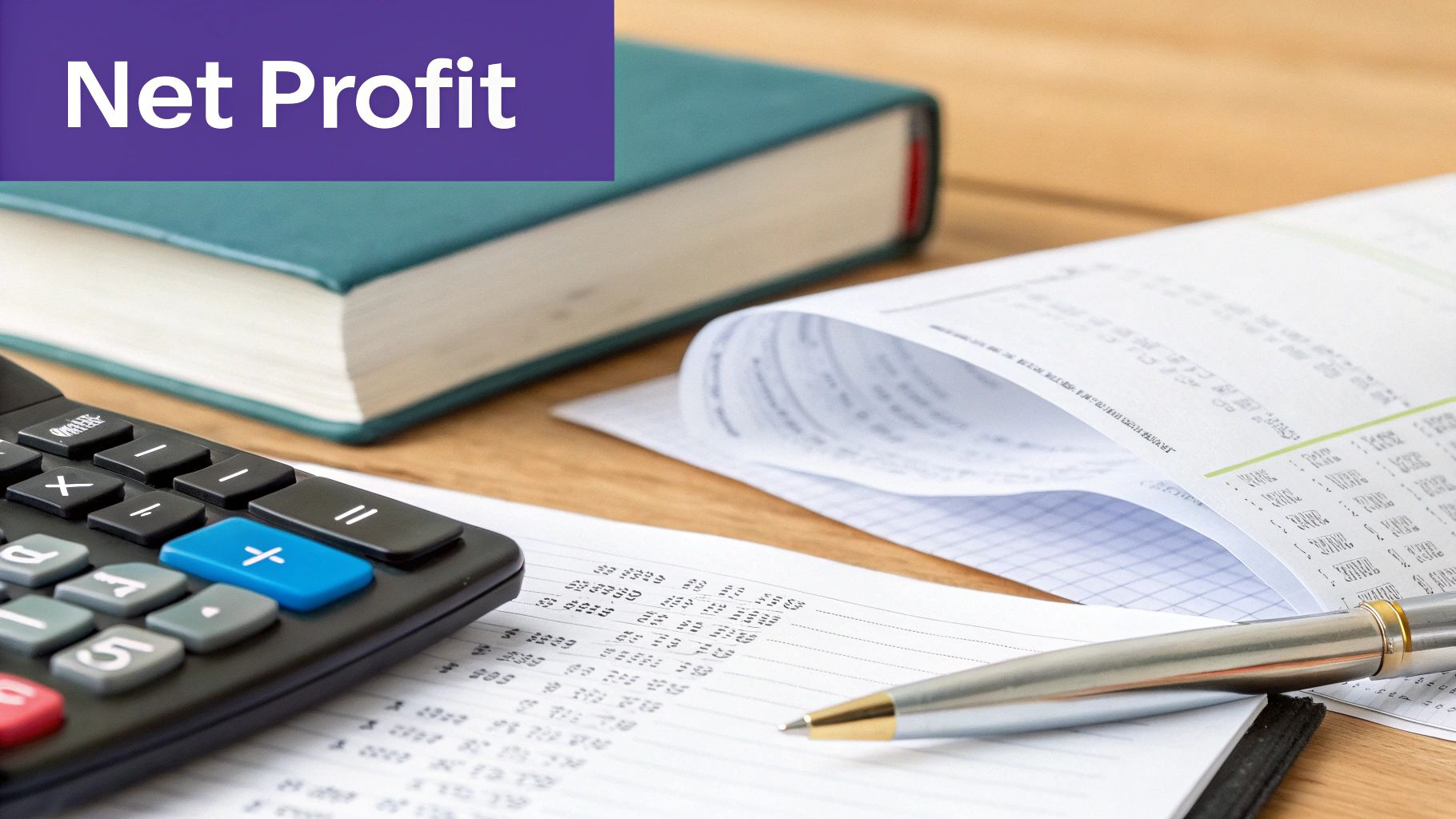
It’s easy to get excited when you see a big payout from a guest booking. But that number—your gross revenue—is only the top-line figure. The number that really matters is your net profit: what’s left in your pocket after every last expense has been paid.
Think of it like a paycheck. Your salary is your gross pay, but your take-home pay is what actually hits your bank account after taxes and deductions. To get a real sense of your property's financial health, you have to shift your focus from simply seeing revenue to meticulously calculating profit.
The Two Types of Airbnb Expenses
To accurately nail down your average Airbnb income, you have to account for every single dollar going out. These costs typically fall into two buckets: one-time startup costs and ongoing operational expenses. Ignore either one, and you’re flying blind.
Let’s break down what you need to be tracking.
- Startup Costs: These are the initial investments you make to get your property ready for its first guest. Think of it as the price of admission to the hosting game.
- Ongoing Expenses: These are the recurring costs that keep your rental running smoothly month after month. They're the engine of your business.
Understanding and budgeting for both is the first real step toward building a profitable Airbnb that lasts.
Calculating Your Startup Investment
Before you can even think about welcoming guests, you need to get the space ready. These upfront costs can vary wildly depending on your property's condition, but they are a critical piece of your financial puzzle.
Key startup expenses usually include:
- Furniture and Decor: Beds, sofas, tables, art—everything needed to create an inviting vibe.
- Kitchenware and Appliances: From the coffee maker and toaster to plates, glasses, and silverware.
- Linens and Towels: High-quality bedding and bath towels are non-negotiable if you want good reviews.
- Safety Equipment: Smoke detectors, carbon monoxide detectors, fire extinguishers, and a first-aid kit are essential.
- Professional Photography: This is your single best marketing tool. Don't skip it.
These upfront costs directly affect how quickly you'll see a return on your investment, so track them carefully.
Tracking Recurring Operational Costs
Once your Airbnb is live, a whole new set of expenses will start hitting your bank account every month. These are the costs that chip away at your gross revenue, and you have to watch them like a hawk to understand your true profit margin.
The most successful hosts operate like business owners, not just property owners. They obsess over their profit and loss statements, understanding that small, recurring expenses can have a massive impact on their annual bottom line.
Common ongoing expenses include:
- Platform Fees: Airbnb typically charges hosts a service fee, which is usually around 3% of the booking subtotal. The platform's own earnings come from these host and guest fees, and they're growing—a sign of rising guest demand but also a more competitive field. You can learn more about the platform's growth and what it means for hosts on SearchLogistics.com.
- Cleaning Fees: Whether you hire a professional or pay yourself for your time, cleaning is a major operational cost.
- Utilities: Internet, electricity, water, gas, and any streaming services you offer.
- Restocking Supplies: Toilet paper, paper towels, coffee, soap, and other guest consumables add up.
- Maintenance and Repairs: Things break. A leaky faucet or a dead microwave is inevitable, so you need to budget for it.
- Taxes: Don't forget income tax on your earnings, plus any local lodging or occupancy taxes your city requires.
Once you subtract all these ongoing costs from your gross revenue, you finally arrive at your net profit. That’s the real measure of your Airbnb's success.
Diving Into Your Top Airbnb Income Questions
Once you get a handle on the difference between revenue and profit, the real-world questions start popping up. It's one thing to understand the concepts, but it's another to apply them when you're just starting out. This is where we tackle those common "what if" and "how do I" scenarios head-on.
Think of this section as your practical field guide. We've rounded up the questions every new host asks to give you clear, straightforward answers. The goal is to help you sidestep common mistakes and build a successful hosting business from day one.
How Long Does It Take to Start Making Consistent Income?
This is probably the number one question on every new host's mind. While we'd all love to see the cash flowing in immediately, building a steady income stream on Airbnb is more like growing a garden than flipping a switch. It takes a little patience and the right strategy.
Most new hosts should expect a 3 to 6-month ramp-up period to really build momentum. Your first few bookings are everything. They're your chance to earn those crucial positive reviews, which act as social proof and are the single biggest factor in boosting your listing's visibility. Without reviews, you're practically invisible.
To lock in those first bookings, you'll likely need to price your property a bit lower than the established competition. Don't think of it as losing money—think of it as a smart, short-term investment in your long-term reputation.
"Consistent" income on Airbnb doesn't mean you'll earn the same amount every month. Far from it. It means you have a predictable rhythm of high and low seasons. A ski cabin, for example, might pull in 75% of its annual income in just four winter months. That predictable cycle is its consistency.
Can I Make a Full-Time Living From Just One Airbnb?
The dream of ditching the 9-to-5 for a single, high-earning rental is a powerful one. But is it realistic? The honest answer is: it depends. It's certainly possible, but it's the exception, not the rule. Success comes down to your specific property, your market, and your personal financial goals.
A luxury villa in a year-round hotspot like Miami could absolutely generate enough revenue to replace a full-time salary. But for a more typical property in an average market, the average Airbnb income is better viewed as a powerful supplement to your primary earnings, not a total replacement.
So, how do hosts really achieve financial freedom? They scale. The most successful operators don't rely on a single door; they build a portfolio of properties. This approach not only multiplies their income but also spreads out the risk. If one property has a slow month, the others are there to pick up the slack, creating a much more stable financial base.
What Are the Biggest Mistakes That Hurt Income?
Knowing what not to do is just as important as knowing what to do. In their excitement to get started, new hosts often stumble into a few common traps that can seriously kneecap their earning potential right from the start.
Avoiding these four income-killers is key to maximizing your profit:
- Poor Quality Photos: Your photos are your storefront. They’re the most important marketing tool you have. Dark, blurry, or misleading pictures will send potential guests clicking away before they even read your description. Professional photography isn't a luxury; it’s a non-negotiable cost of doing business.
- Static Pricing: Setting one price and forgetting it is a guaranteed way to leave money on the table. You have to be dynamic. Your rates need to adjust for weekends, holidays, local festivals, and seasonal demand. A smart pricing strategy ensures you're earning top dollar during peak times while staying booked during the slow season.
- Underestimating Expenses: It’s so easy to get mesmerized by big revenue numbers and forget about all the little costs that eat into your profit. Forgetting to budget for cleaning, supplies, taxes, surprise maintenance, and platform fees leads to a nasty shock when you finally sit down to calculate what you actually made.
- Slow Communication: Guests today expect instant answers. If you take hours (or even a day) to reply to an inquiry, they won't wait around. They'll just move on and book with a host who responds in minutes. Slow response times are a direct cause of lost bookings and can even lead to bad reviews.
Ready to turn these insights into action? The first step to a successful short-term rental investment is knowing your numbers. Chalet provides a free, powerful Airbnb calculator and AI-driven market analytics to help you estimate revenue, understand your market, and make data-backed decisions. Analyze any property in the U.S. and connect with expert STR agents, all in one place. Start your investment journey with confidence at https://www.getchalet.com.



